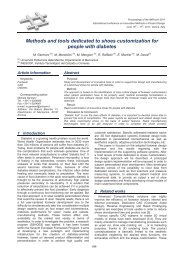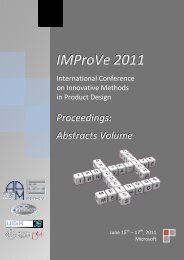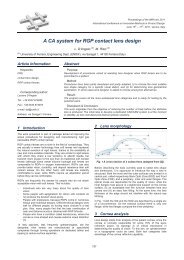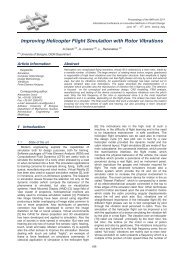IMProVe 2011 - Proceedings
IMProVe 2011 - Proceedings
IMProVe 2011 - Proceedings
Create successful ePaper yourself
Turn your PDF publications into a flip-book with our unique Google optimized e-Paper software.
Industrial Design and Ergonomics<br />
Keywords: Comfort Evaluation Criteria, Ergonomic, Design Methods, Movie-theatre<br />
design, Digital Human Modeling<br />
Corresponding Author: Alessandro Naddeo<br />
Tel.:+39 089 964061<br />
Fax.:+39 089 964037<br />
e-mail: anaddeo@unisa.it<br />
Address: Via Ponte don Melillo, 84048 Fisciano (SA), Italy<br />
Synthetic<br />
A. M. Manferdini (a), E. Manferdini (b)<br />
(a) Faculty of Architecture, University of Bologna, Italy<br />
(b) SCI-Arc Southern California Institute of Architecture, Los Angeles, USA<br />
Abstract:<br />
Purpose:<br />
The aim of this paper is to show the results of a research whose aim is to investigate the<br />
potential of architectural surfaces to produce hyper-realistic effects through the invention<br />
of new breeds of artificial matter, using Nature and the observation of its micro-scale<br />
details as a field of investigation which is instrumental in analyzing and understanding its<br />
structure and behaviour.<br />
Method:<br />
The research started from the digital three-dimensional acquisition of case studies drawn<br />
from plant and animal kingdom that were chosen as significant in terms of shape<br />
complexity and of the levels of detail of their geometry. Physical 3D models have been<br />
built using artificial materials with the purpose to extend the potential of digital surfaces<br />
and experience new visual and tactile effects. Modulation of texture, relief and colours<br />
derived from 3D scanned materials were the primary design sources. CNC machines<br />
combined with various techniques of tooling, laser etching, casting, vacuum forming,<br />
painting, and finishing were employed to fabricate physical model of the digital 3d<br />
acquisitions. The research provided a continuous transition from digital reality to the<br />
physical one: through the whole process, both analogical and digital procedures were<br />
used as agents of comprehension and design innovation.<br />
Result:<br />
One of the challenges of this research was to test the possibilities of enlarging the<br />
dimensions of micro-scale details acquired using 3d laser scanners, without losing<br />
geometric detail. During the digital manipulation process, the quality of 3d models has<br />
constantly been compared to the required level of details provided by magnification of 2d<br />
images. In order to supply the lack of information due to laser scanner accuracy and<br />
resolution, reality-based models have been implemented using 3d modelling packages<br />
that allow adding the third dimension to 2d images. This improvement added hyperrealistic<br />
effects to digital models, with evident drawback upon the possibility of managing<br />
huge data sets, so that decimation procedures became necessary to overcome this aspect.<br />
June 15 th – 17 th , <strong>2011</strong>, Venice, Italy<br />
19<br />
<strong>IMProVe</strong> <strong>2011</strong> - <strong>Proceedings</strong>










